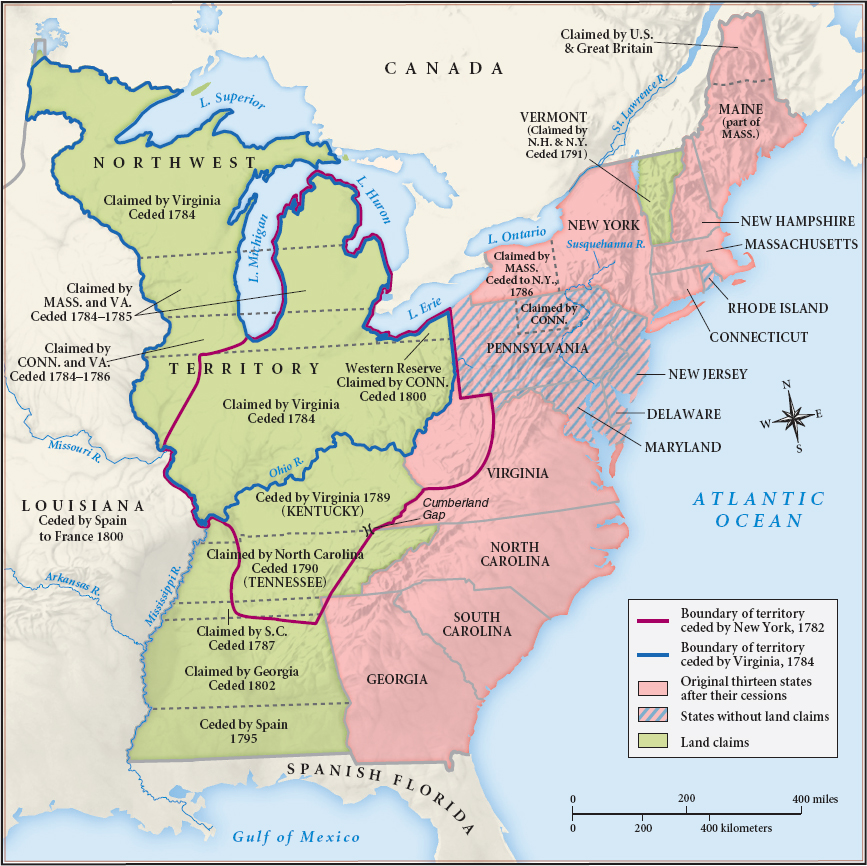The Articles of Confederation
As Patriots embraced independence in 1776, they envisioned a central government with limited powers. Carter Braxton of Virginia thought the Continental Congress should “regulate the affairs of trade, war, peace, alliances, &c.” but “should by no means have authority to interfere with the internal police [governance] or domestic concerns of any Colony.”
That idea informed the Articles of Confederation, which were approved by the Continental Congress in November 1777. The Articles provided for a loose union in which “each state retains its sovereignty, freedom, and independence.” As an association of equals, each state had one vote regardless of its size, population, or wealth. Important laws needed the approval of nine of the thirteen states, and changes in the Articles required unanimous consent. Though the Confederation had significant powers on paper — it could declare war, make treaties with foreign nations, adjudicate disputes between the states, borrow and print money, and requisition funds from the states “for the common defense or general welfare” — it had major weaknesses as well. It had neither a chief executive nor a judiciary. Though it could make treaties, it could not enforce their provisions, since the states remained sovereign. Most important, it lacked the power to tax either the states or the people.
Although the Congress exercised authority from 1776 — raising the Continental army, negotiating the treaty with France, and financing the war — the Articles won formal ratification only in 1781. The delay stemmed from conflicts over western lands. The royal charters of Virginia, Massachusetts, Connecticut, and other states set boundaries stretching to the Pacific Ocean. States without western lands — Maryland and Pennsylvania — refused to accept the Articles until the land-rich states relinquished these claims to the Confederation. Threatened by Cornwallis’s army in 1781, Virginia gave up its claims, and Maryland, the last holdout, finally ratified the Articles (Map 6.5).

Continuing Fiscal Crisis By 1780, the central government was nearly bankrupt, and General Washington called urgently for a national tax system; without one, he warned, “our cause is lost.” Led by Robert Morris, who became superintendent of finance in 1781, nationalist-minded Patriots tried to expand the Confederation’s authority. They persuaded Congress to charter the Bank of North America, a private institution in Philadelphia, arguing that its notes would stabilize the inflated Continental currency. Morris also created a central bureaucracy to manage the Confederation’s finances and urged Congress to enact a 5 percent import tax. Rhode Island and New York rejected the tax proposal. His state had opposed British import duties, New York’s representative declared, and it would not accept them from Congress. To raise revenue, Congress looked to the sale of western lands. In 1783, it asserted that the recently signed Treaty of Paris had extinguished the Indians’ rights to those lands and made them the property of the United States.
The Northwest Ordinance By 1784, more than thirty thousand settlers had already moved to Kentucky and Tennessee, despite the uncertainties of frontier warfare, and after the war their numbers grew rapidly. In that year, the residents of what is now eastern Tennessee organized a new state, called it Franklin, and sought admission to the Confederation. To preserve its authority over the West, Congress refused to recognize Franklin. Subsequently, Congress created the Southwest and Mississippi Territories (the future states of Tennessee, Alabama, and Mississippi) from lands ceded by North Carolina and Georgia. Because these cessions carried the stipulation that “no regulation … shall tend to emancipate slaves,” these states and all those south of the Ohio River allowed human bondage.
However, the Confederation Congress banned slavery north of the Ohio River. Between 1784 and 1787, it issued three important ordinances organizing the “Old Northwest.” The Ordinance of 1784, written by Thomas Jefferson, established the principle that territories could become states as their populations grew. The Land Ordinance of 1785 mandated a rectangular-grid system of surveying and specified a minimum price of $1 an acre. It also required that half of the townships be sold in single blocks of 23,040 acres each, which only large-scale speculators could afford, and the rest in parcels of 640 acres each, which restricted their sale to well-to-do farmers (Map 6.6).

Finally, the Northwest Ordinance of 1787 created the territories that would eventually become the states of Ohio, Indiana, Illinois, Michigan, and Wisconsin. The ordinance prohibited slavery and earmarked funds from land sales for the support of schools. It also specified that Congress would appoint a governor and judges to administer each new territory until the population reached 5,000 free adult men, at which point the citizens could elect a territorial legislature. When the population reached 60,000, the legislature could devise a republican constitution and apply to join the Confederation.
The land ordinances of the 1780s were a great and enduring achievement of the Confederation Congress. They provided for orderly settlement and the admission of new states on the basis of equality; there would be no politically dependent “colonies” in the West. But they also extended the geographical division between slave and free areas that would haunt the nation in the coming decades. And they implicitly invalidated Native American claims to an enormous swath of territory — a corollary that would soon lead the newly independent nation, once again, into war.
COMPARE AND CONTRAST